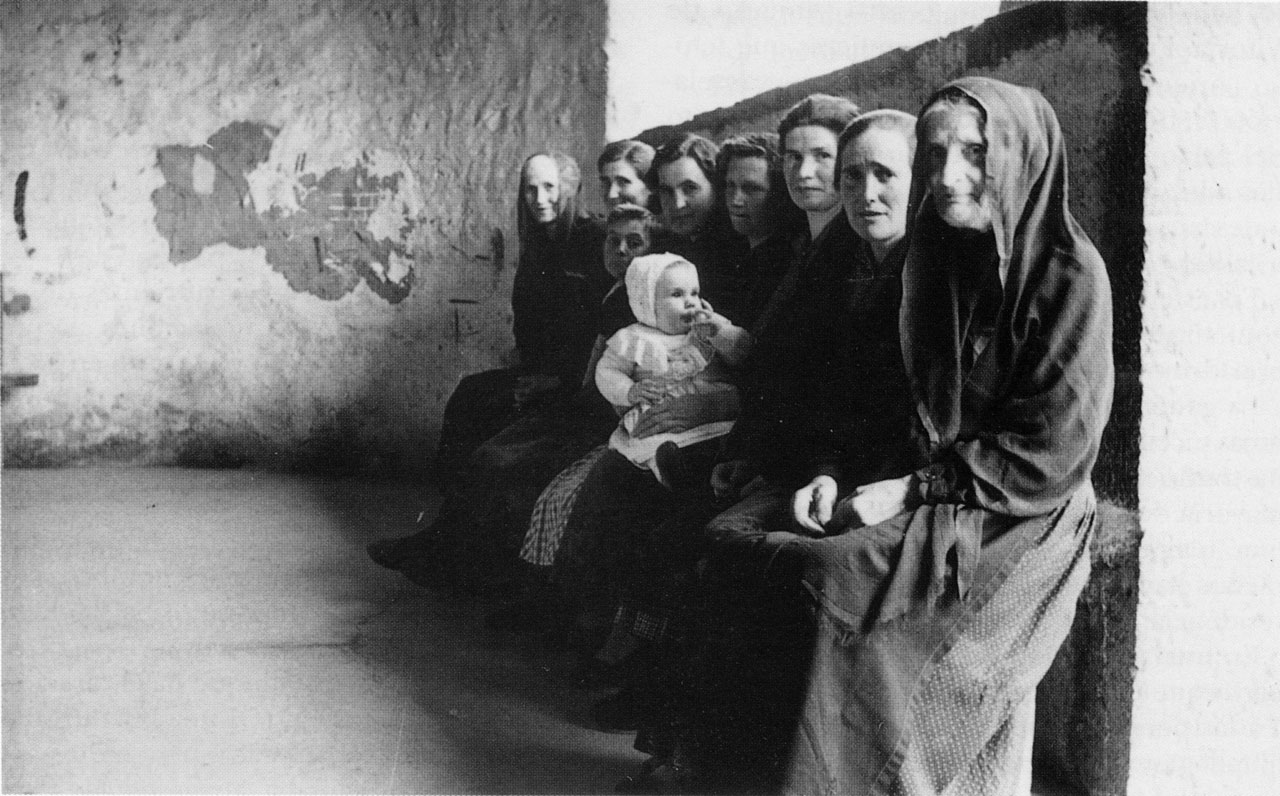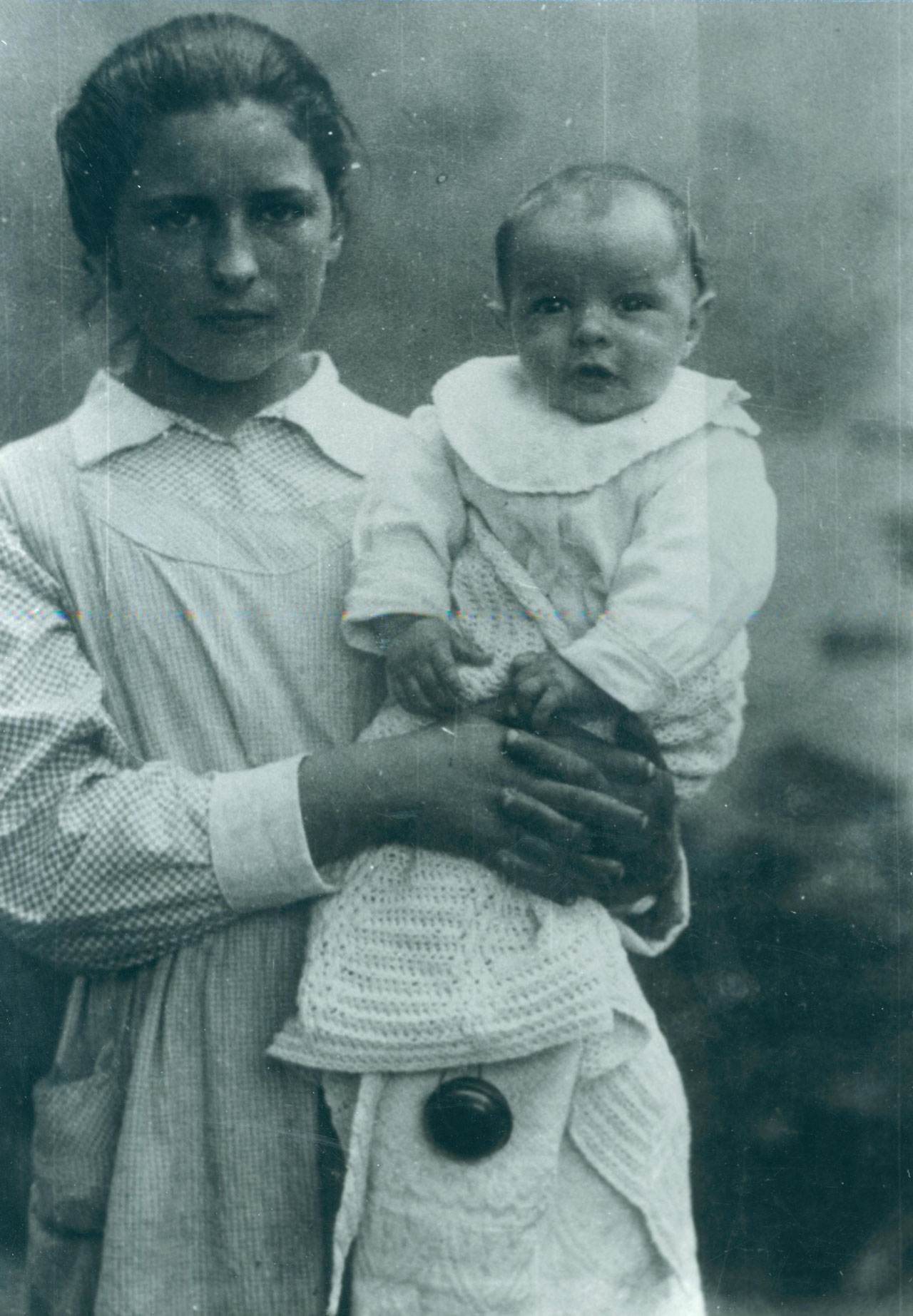Diferencia entre revisiones de «Ritos del nacimiento al matrimonio en vasconia/en»
De Atlas Etnográfico de Vasconia
| Línea 13: | Línea 13: | ||
| − | ====[/atlas/nacimiento/Familia-troncal-Castillo-Elejabeitia-1930.jpg|Nuclear family. Artea (B), c. 1930. Source: Labayru Fundazioa Photograhic Archive: Felipe Manterola Collection.|Any bachelor, or spinster, traditionally continued to be linked to the homestead and to be an integral part of the family.|| | + | ====[/atlas/nacimiento/Familia-troncal-Castillo-Elejabeitia-1930.jpg|Nuclear family. Artea (B), c. 1930. Source: Labayru Fundazioa Photograhic Archive: Felipe Manterola Collection.|Any bachelor, or spinster, traditionally continued to be linked to the homestead and to be an integral part of the family.||]==== |
| − | ====[/atlas/nacimiento/Seintzaina-Zeanuri-1924.jpg|Nursemaid. Zeanuri (B), 1924. Source: Labayru Fundazioa Photograhic Archive: Felipe Manterola Collection.|Until the mid-twentieth century women gave birth at home with the help of a midwife and women relatives and neighbours. Giving birth was almost exclusively a female domestic occasion exclusively concerning females.|| | + | ====[/atlas/nacimiento/Seintzaina-Zeanuri-1924.jpg|Nursemaid. Zeanuri (B), 1924. Source: Labayru Fundazioa Photograhic Archive: Felipe Manterola Collection.|Until the mid-twentieth century women gave birth at home with the help of a midwife and women relatives and neighbours. Giving birth was almost exclusively a female domestic occasion exclusively concerning females.||]==== |
| − | ====[/atlas/nacimiento/Mozas-en-el-paseo-Aoiz-1950.jpg|Promenading. Aoiz (N), 1950. Source: Pilar Sáez de Albéniz, Etniker Euskalerria Groups.|Neskazaharrak joaten dira <br />Madalenara, <br />santuari eskatzera <br />senar on bana. <br /><br />''Folk song''|| | + | ====[/atlas/nacimiento/Mozas-en-el-paseo-Aoiz-1950.jpg|Promenading. Aoiz (N), 1950. Source: Pilar Sáez de Albéniz, Etniker Euskalerria Groups.|Neskazaharrak joaten dira <br />Madalenara, <br />santuari eskatzera <br />senar on bana. <br /><br />''Folk song''||]==== |
| − | ====[/atlas/nacimiento/Despedida-de-soltera-Durango-1960.jpg|Single farewell. Durango (B), 1960. Source: Gurutzi Arregi, Etniker Euskalerria Groups.|The transfer of the chattels was a ritualised act of great importance as it marked the entry of the new spouse in the home, ''etxe-sartzea''.|| | + | ====[/atlas/nacimiento/Despedida-de-soltera-Durango-1960.jpg|Single farewell. Durango (B), 1960. Source: Gurutzi Arregi, Etniker Euskalerria Groups.|The transfer of the chattels was a ritualised act of great importance as it marked the entry of the new spouse in the home, ''etxe-sartzea''.||]==== |
| − | ====[/atlas/nacimiento/Bautismo-Bilbao.jpg|Baptism. Bilbao. Source: Edurne Romarate, Etniker Euskalerria Groups.|After giving birth, women would remain confined for a period that ended with the rite of being churched, ''elizan sartzea''.|| | + | ====[/atlas/nacimiento/Bautismo-Bilbao.jpg|Baptism. Bilbao. Source: Edurne Romarate, Etniker Euskalerria Groups.|After giving birth, women would remain confined for a period that ended with the rite of being churched, ''elizan sartzea''.||]==== |
| − | ====[/atlas/nacimiento/Etxebarri-1968.jpg|Etxebarri (B), 1968. Source: Edurne Romarate, Etniker Euskalerria Groups.|Maritxu-teilatuko, <br />gona gorriduna, <br />eutsi hagin zaharra <br />ta ekarzu barria. <br /><br />''Popular recitation''|| | + | ====[/atlas/nacimiento/Etxebarri-1968.jpg|Etxebarri (B), 1968. Source: Edurne Romarate, Etniker Euskalerria Groups.|Maritxu-teilatuko, <br />gona gorriduna, <br />eutsi hagin zaharra <br />ta ekarzu barria. <br /><br />''Popular recitation''||]==== |
| − | ====[/atlas/nacimiento/Entrada-en-el-templo-Getxo-1996.jpg|Bride’s entrance in church. Getxo (B), 1996. Source: Labayru Fundazioa Photograhic Archive.|Ezkon urte, ero urte. <br />''People go crazy in the year they wed.''|| | + | ====[/atlas/nacimiento/Entrada-en-el-templo-Getxo-1996.jpg|Bride’s entrance in church. Getxo (B), 1996. Source: Labayru Fundazioa Photograhic Archive.|Ezkon urte, ero urte. <br />''People go crazy in the year they wed.''||]==== |
| − | ====[/atlas/nacimiento/Mozas-en-el-paseo-Aoiz-1950.jpg|Offering to the departed. Donostia, 1958. Source: Segundo Oar-Arteta, Etniker Euskalerria Groups.|Ezkonberri, etxe berri. <br />''A married person wants a house.''|| | + | ====[/atlas/nacimiento/Mozas-en-el-paseo-Aoiz-1950.jpg|Offering to the departed. Donostia, 1958. Source: Segundo Oar-Arteta, Etniker Euskalerria Groups.|Ezkonberri, etxe berri. <br />''A married person wants a house.''||]==== |
| − | ====[/atlas/nacimiento/Urduliz-1984.jpg|Urduliz (B), 1984. Source: Akaitze Kamiruaga, Etniker Euskalerria Groups.|Haurrak negarrik ez, titirik ez. <br />''A baby who does not cry, does not suckle.''|| | + | ====[/atlas/nacimiento/Urduliz-1984.jpg|Urduliz (B), 1984. Source: Akaitze Kamiruaga, Etniker Euskalerria Groups.|Haurrak negarrik ez, titirik ez. <br />''A baby who does not cry, does not suckle.''||]==== |
| − | ====[/atlas/nacimiento/Boloak-Zerain-1970.jpg|Baptism celebration. Zerain (G), 1970. Source: Karmele Goñi, Etniker Euskalerria Groups.|Haurraren jaiotza, etxerako poza. <br />''A house without children is a flowerpot without flowers.''|| | + | ====[/atlas/nacimiento/Boloak-Zerain-1970.jpg|Baptism celebration. Zerain (G), 1970. Source: Karmele Goñi, Etniker Euskalerria Groups.|Haurraren jaiotza, etxerako poza. <br />''A house without children is a flowerpot without flowers.''||]==== |
| − | ====[/atlas/nacimiento/Bilbao-1995.jpg|Bilbao, 1995. Source: Asier Astigarraga’s private archive.|Charms, ''kutunak'', were attached to children’s clothes and were said to protect them from the evil eye.|| | + | ====[/atlas/nacimiento/Bilbao-1995.jpg|Bilbao, 1995. Source: Asier Astigarraga’s private archive.|Charms, ''kutunak'', were attached to children’s clothes and were said to protect them from the evil eye.||]==== |
| − | ====[/atlas/nacimiento/Pasacalles-Sanguesa-1960.jpg|Passacaglia. Sangüesa (N), c. 1960. Source: Juan Cruz Labeaga, Etniker Euskalerria Groups.|Gazteak, badakizue <br />zelan dantzan egin: <br />burua gora-gora <br />ta kaderai eragin. <br /><br />''Folk verse''|| | + | ====[/atlas/nacimiento/Pasacalles-Sanguesa-1960.jpg|Passacaglia. Sangüesa (N), c. 1960. Source: Juan Cruz Labeaga, Etniker Euskalerria Groups.|Gazteak, badakizue <br />zelan dantzan egin: <br />burua gora-gora <br />ta kaderai eragin. <br /><br />''Folk verse''||]==== |
{{DISPLAYTITLE: Rites from Birth to Marriage in the Basque Country}} {{#bookTitle:Rites from Birth to Marriage in the Basque Country | Ritos_del_nacimiento_al_matrimonio_en_vasconia/en}} | {{DISPLAYTITLE: Rites from Birth to Marriage in the Basque Country}} {{#bookTitle:Rites from Birth to Marriage in the Basque Country | Ritos_del_nacimiento_al_matrimonio_en_vasconia/en}} | ||
Revisión del 12:19 10 feb 2020

Rites from Birth to Marriage in the Basque Country
Significant stages of life and rites of passage; namely, birth and childhood, youth, and the transition from singleness to marriage.
Nuclear family. Artea (B), c. 1930. Source: Labayru Fundazioa Photograhic Archive: Felipe Manterola Collection.



